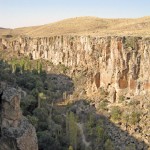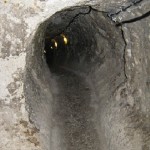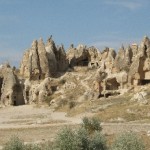
Along with Fairy Chimneys, the other unique attraction in Cappadocia is a whole series of Underground Churches, carved into the soft rock. Most have been decorated internally with an amazing variety of wall paintings and frescoes. There are rock carved Churches scattered right across Cappadocia but some of the most interesting and best preserved, lie in the upper part of the Göreme Valley, a few kilometres west of Ürgüp.
Christians settled in this part of Cappadocia in the second and third centuries AD. They carved and built these Churches and associated settlements, seeking to escape Roman persecution of their faith. After the Roman Empire adopted the Christian faith, there was less need to hide away in this remote area. But monastic and teaching communities remained.
From the seventh century AD and onwards, the increasing spread of Islam led more Christians to settle or re-settle here. Existing Churches were altered and expanded and newer ones carved out of the soft rock. From what I can discover, these Churches were not abandoned until sometime in the thirteenth century.
When I stayed in Ürgüp and visited these fascinating Churches in the Göreme Valley back in 1975, there were relatively few visitors and virtually no tourist infrastructure. A local Turkish young man took us around, showing us how to reach some of the more interesting and accessible ones. Access to some Churches was by steps cut into the cliff face which would send present-day health and safety executives into apoplexy.
|
|
|
This complex of Churches is now designated the Göreme Valley Open-Air Museum. The whole area is fenced off and managed. An entrance fee is charged, access paths made of stone cobbles have been laid, and ladders with handrails erected to allow for safer access to the Churches. Below the pedestrian entrance to the site, there is a coach and car park, with the usual associated stalls selling touristy souvenirs.
|
|
|
Inevitably, many of the wall paintings and frescoes are damaged. Partly this is due to damp, wind and temperature change. But many of the paintings at lower levels were also vandalised in the past by shepherd boys and similar people who used the cave Churches for shelter and believed, according to Islam, that the images were sinful. Certainly the paintings and frescoes are now being protected from any further damage, flashlight photography is banned and it would appear that at least some are beginning to be restored.
|
|
|
|
|
|
The iconic image of Christ Pantocrator was one of the first images of Christ developed in the Early Christian Church and remains a central icon of the Eastern Orthodox Church. In the half-length image, Christ holds the New Testament in his left hand and makes the gesture of teaching or of blessing with his right. Below are two different examples from the Göreme Underground Churches taken 35 years apart.
|
|
|
Some of the early decoration of the Churches was quite simple in design and done with red pigment directly onto the walls. An example of this is below left. Later decoration was much more advanced with what is clearly recognisable as an Eastern Orthodox artistic style. These paintings were usually done on a thin layer of plaster laid over the bare stone walls, often covering up the earlier simple decoration.
|
|
|
Here from the Tokali Church, the largest Church in the Goreme Valley, is an example of both early and later styles of decoration. It is possible to see where some later painting on plaster has been placed over the earlier simple decoration that had been painted directly on the rock walls.

















This reminds me of those giant Buddhas the Taliban blew up in Afghanistan. If only they had build a Hilton and started charging $10 a head…..By the way, you should be proud to be so organized you have pictures from 1975 hanging around.
.-= Karen´s last blog ..Free Beer and Chillin’ with President Vaclav Klaus =-.
Amazing! I went there in the 70’s too and I have to say it was one of the most memorable experiences I’ve had, especially as a practicing christian. I wish I would have had my camera back then but your pictures capture it perfectly.
.-= Denver Photographer´s last blog ..There’s more than one way to devour a Mac Life =-.